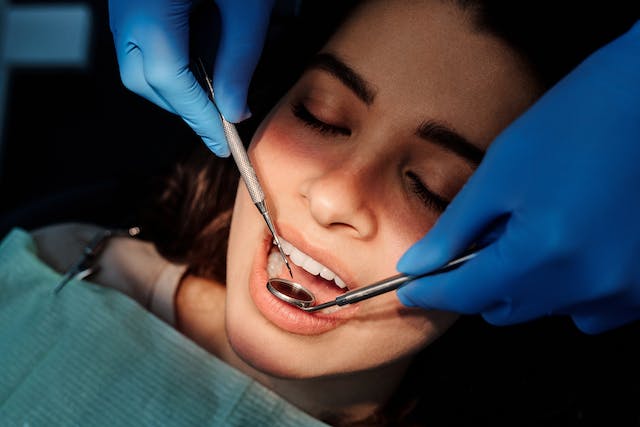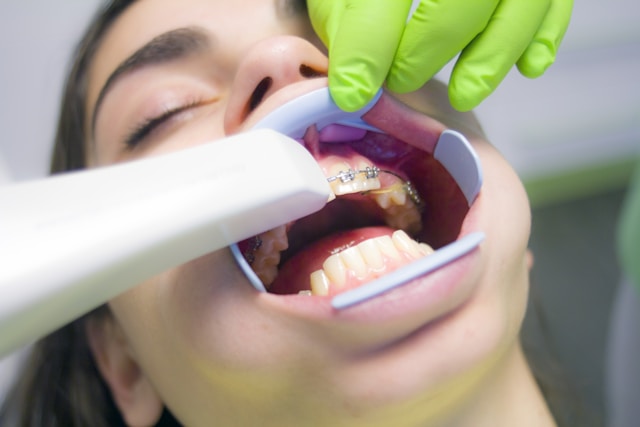If you’re considering braces in Melbourne, our Melbourne CBD clinic provides metal and ceramic braces, with recommendations based on your orthodontic needs and the level of correction required. Metal braces prices range from $2,000 to $8,000, and ceramic braces from $6,500 to $9,500, with all fees explained clearly at your appointment. You can book an online consultation if you’d like tailored advice on your braces options.
Results do vary from person to person. To read more on treatment risks and considerations, please see here.

Traditional metal braces in Melbourne cost between $2,000 and $8,000. The cost varies depending on the issue you are addressing, the severity of your case, and how long the treatment will last. The cost of your braces will include dental check-ups and adjustments to your braces, ensuring they remain comfortable and allow you to achieve your dream smile.
We have outlined the price ranges for braces and similar treatment options to help you compare your options. The breakdown shows you the typical price range of each treatment and what is inlcuded to help narrow your choice.
Treatment | Price | What's included |
Metal braces | from $2,000 to $8,000 | Complete orthodontic treatment |
Ceramic braces | from $6,500 to $9,500 | Complete orthodontic treatment |
Invisalign | from $3,500 to $8,900 | Custom aligners, regular check-ups, a smile preview, whitening, and retainers |
Lingual braces | from $5,000 | Complete orthodontic treatment |
We understand that not everyone can afford to pay upfront for their braces treatment, especially when they are committing to years of ongoing treatment. To ensure everyone can access the treatment they need, we offer several payment plans that allow you to spread the cost, including our interest-free payment plans. Our interest-free plans ensure you never need to spend more than you should to access dental care. We have outlined the main features you need to know about our payment plans below:
Our flexible and interest free-dental payment plans feature simple terms and easy management options, allowing you to remain in control. Details of our interest-free payment plans for braces include:
You can learn more about our payment plan options and eligibility here to see which payment option is right for you. You can also book a consultation to speak to us directly and learn more about your options.
The braces treatment follows six steps that take you to the smile of your dreams. We have detailed what you can expect on your orthodontic journey below:
















Braces are perfect for straightening teeth and giving you a smile you can be proud of, as you can see from our before and after photos! Head to our gallery to see more before and after photos of braces treatments.






Braces are an orthodontic device that allows you to address jaw problems and misaligned teeth to help you create the perfect smile. Braces are usually recommended for gapped teeth, crowding, and bite issues. Braces are traditionally metal and feature brackets on each tooth, connected with a wire that adds gradual pressure to move the teeth into their desired location. These fixed braces have been popular with orthodontists for years, although you can now opt for clear ceramic braces or lingual braces if you want something more discreet. Book a consultation appointment with one of our dentists to learn about the types of braces we offer and the concerns they can address.
Braces add pressure to your teeth, slowly shifting them into your new position. Metal braces feature metal brackets bonded to your teeth and connected by a thin wire. This wire is then attached to brackets using rubber bands or ligatures. The wire will add pressure to the brackets, gradually moving your teeth. While this can sound painful, the moving process is slow, and at most, you will feel a little uncomfortable when the braces are first installed.
Braces in Melbourne cost between $2,000 and $9,000, depending on the type of braces you choose. Traditional metal braces are usually the cheaper option, while ceramic and lingual braces will be more expensive. The cost can also vary depending on your smile goals and how difficult it will be to achieve them. You can discuss the cost of your braces in more detail with one of our dental experts by booking a consultation.
Braces treatment can take between one and three years, with the average treatment time being 18 months. How long your braces treatment takes will depend on your treatment goals and the severity of your case. Straightening a few teeth will take less time than addressing severe bite issues or reducing overcrowding. During your consultation, you will be provided with an estimated time frame for your treatment, which will be updated as your treatment progresses.
Braces can cause some discomfort or pain when they are first installed. Many patients do not describe this as painful, but rather a dull ache and a feeling of discomfort that will pass after a few days. You might notice some soreness when the braces are installed, too, and after adjustments, but the more adjustments you have, the more used to this you become. Should you experience any sharp or sudden pain or feel like the attachments are cutting into your gums, make an appointment with your dentist to address these concerns.
You should avoid hard foods like pizza crust, nuts, hard candies, crunchy foods like thick-cut crisps and popcorn, and sticky foods like caramel and chewing gum while wearing braces. These foods can either get stuck in your braces or damage them, requiring you to attend dental appointments to have your braces adjusted or replaced. While wearing braces, you should also reduce sugary and acidic foods, and cut hard fruits and vegetables into smaller pieces to prevent them from damaging your braces.
Typically, you will have adjustment appointments every four to eight weeks. How often you have your adjustment appointments will depend on your treatment plan and how quickly your teeth are moving into their new position. Usually, your dentist will recommend how often your adjustment appointments will be, but this might be changed if they need to be brought forward or pushed back.
Adults can have braces! You can have braces at any age; they aren't just for kids. While braces are typically seen on children, it is becoming increasingly popular for adults to address smile concerns with braces. For adults, we can recommend more discreet braces options, like ceramic or lingual braces, to help them remain confident while creating their new smile.
The materials used are the biggest difference between metal, ceramic, and lingual braces. Metal braces are made with metal brackets bonded to your teeth and a wire that connects them, using pressure to move the teeth into their new place.
Ceramic braces are made using clear ceramic to make them less visible than traditional metal braces, but they function the same way as metal braces do. You can learn more about ceramic braces and their benefits here. Lingual braces are slightly different, with brackets attached to the back of your teeth for an undetectable appearance. Lingual braces are often used for alignment issues, but their higher price and discomfort make them unsuitable for some patients. Learn more about lingual braces and their benefits to see if they are a good option for you.To clean your teeth with braces on, you must use a special brace or a soft-bristle toothbrush and fluoride toothpaste. You will move the toothbrush across your teeth, paying attention to the gumline and moving the brush above and below each wire and bracket. You will need to clean your teeth more frequently, including after every meal, to remove food particles and keep your teeth healthy. You will also need to floss regularly to remove food particles from hard-to-reach areas. We provide detailed aftercare guidelines to help you care for your braces and new smile.
Retainers are typically needed after braces to keep your teeth in their new position. Most patients will need to wear retainers every night after having braces to ensure their teeth do not move back to their original positions. Your dentist will walk you through how long your retainer needs to be worn and the best way to clean and care for it.
Medicare will only cover the cost of braces if they are medically necessary. For braces to be considered medically necessary, they typically need to be related to an injury, accident, or health condition. In cases where your Medicare package comes with dental benefits, you might be able to claim for braces, but you will need to check your package carefully.